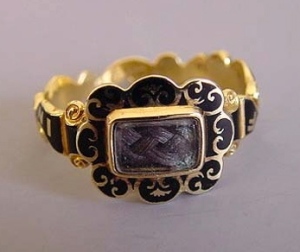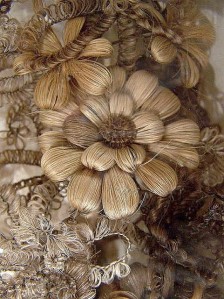
Victorian table worked human hair and gold brooch.
Steve and I have long been intrigued with 19th-century hair work objects. We’re drawn to the fragility, intimacy, and sentimentality of these objects, executed in incredibly painstaking detail from a most delicate and personal material, human hair.

Gold and enamel mourning ring with hair of the deceased under glass, c. 1855.
Frequently made into jewelry, hair was also used to create decorative art works. In fact, the variety of objects made with hair seems limitless, ranging from a simple lock of hair tucked into a locket, to intricate wreaths made of hair woven into flowers, to miniature paintings on ivory with sepia paint made from finely chopped hair. Hair from deceased loved ones was frequently used in mourning pieces, but more often the hair of the living was worked into sentimental keepsakes given as everlasting tokens of friendship, remembrance, or romantic love.

Mourning brooch of gold and enamel, with simply plaited hair of the deceased encased in glass, c. 1848.
Although the use of hair in jewelry dates back many centuries, it reached its apex in form and popularity during the Victorian era, affording Victorians an opportunity to combine their obsession with hair and passion for elaborate ornament with their appreciation of the sentimental and the macabre. Rings, earrings, bracelets, necklaces, brooches, charms, cufflinks, and watch chains made of hair—and often elaborately embellished with gold, enamel, pearls, and precious or semi-precious gems—were all the rage. It didn’t stop there: shadowbox-framed hair wreaths decorated walls, and 3-dimensional bouquets and tableaux made entirely of hair were displayed under glass domes on Victorian parlor tables.

Bouquet of hair worked flowers under glass display dome, New Zealand, 1896.
At the Paris Exposition of 1855, visitors were said to have flocked to a life-sized portrait of Queen Victoria created entirely of human hair. The trend-setting Victoria was fond of hair work, and presented a bracelet made of her own hair to Empress Eugenie of France, who was reportedly moved to tears by the gesture. Following the death of her beloved husband, Prince Albert, in 1861, Victoria wore a lock of his hair in a brooch pinned over her heart for the rest of her life.

Bracelet of finely woven hair accented with gold beads and clasp, before 1850. Probably one of a pair that would have been worn as matched cuffs.
Initially created by artisans and marketed in specialized shops and mail order catalogs, hair work soon became a popular parlor pastime for Victorian women. Publications including Godey’s Lady’s Book and Peterson’s Magazine published free patterns and instructions for DIY hair work projects, and schools were established in England and the US to teach young ladies the skill. Hair receivers became essential parts of a woman’s toilette set, to collect hair harvested from combs and brushes for later use. It has been suggested, only half-jokingly, that by the time hair jewelry began to fall out of fashion at the end of the 19th century, virtually every male had received a hair work watch chain from his fiancée, wife, sister, or mother; watch chains are among the most commonly found examples of 19th-century hair work today.

Victorian watch chain of human hair with gold clasped hand detail.
Below, we’ve assembled a small sampling of hair work, with brief descriptions of some of the techniques involved.

Raw material: a young Victorian woman displays her magnificent tresses.
Palette work: Hair was cut into shapes and glued flat onto a surface such as vellum, ivory, or glass, to create designs that often resemble feathers and flora. Individual hairs could be used to create fine lines, or bits of hair could be sprinkled over the adhesive to add texture.

French palette work mourning hair wreath with hair from the deceased in its original frame, 1887, my gift to Steve on our first Christmas together.
One of the more distinctive devices in palette work was the Prince of Wales curl, made by heating a rod used as a miniature curling iron, fixing the curl with glue, and then weighting it for several hours. Three of these feather-like curls arranged together created the Prince of Wales plume.

Brooch memorializing 2 deceased loved ones, gold and enamel with palette worked Prince of Wales curls from each deceased, seed pearls (representing tears) and gold wirework under glass, c. 1870s.
Table work: Working on a special table with a hole in the center, hair is woven using bobbins and weights into an intricate lace network, and is often embellished with gold or pearls. Table work was especially labor intensive: the hair was first boiled in soda water for 15 minutes, then sorted into lengths
and divided into strands of 20 to 30 hairs. Most pieces of jewelry required long
hair: for example, a bracelet called for hair 20 to 24″ long. Sometimes hair was formed around a wooden mold to create a desired shape, with special shapes made by local wood turners. The mold was attached to the
center hole in the worktable. The hair was wound on a series of bobbins, and
weights were attached to the braid work to
keep the hair straight. When the work was finished and the
mold still in place, it was boiled for 15 minutes, dried and removed carefully from the
mold. It was then ready for mounting by a jeweler.

Brooch of white and brown hair, table worked and embellished with gold by the workshop of Antoni Forrer, 1847-1858. Forrer, a Swiss national, ran the leading hair work studio in London, employed a staff of 50, and included Queen Victoria among his clientele.
Sepia Painting: Hair was chopped finely and added to gum arabic or an adhesive called “musilix,” or ground to a powder with a mortar and pestle and dissolved in distilled water to create a brown pigment that was applied to ivory, glass, or vellum, usually in miniature landscapes or scenes related to death and mourning.

Georgian era mourning ring, sepia paint on ivory under crystal, surrounded by amethysts, depicting a woman standing at a tomb under a weeping willow, weeping into a handkerchief, c. 1784.
Hair Flowers, Bouquets, and Wreaths: Hair flowers were made by wrapping the hair around a rod and using a fine wire to hold it together. By varying the size of the rods, the amount and color of hair used, and sometimes incorporating beads, many different shapes and sizes of flowers, leaves, and tendrils could be made and then joined into decorative bouquets or wreaths.

Victorian hair wreath in shadowbox frame.

Detail, hair flowers.
—Lynne Adele













